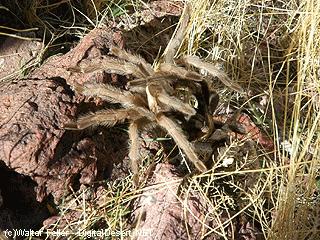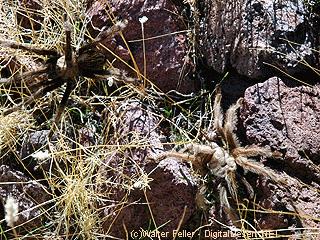/wildlife/tarantula.html

The mating process of tarantulas, like many other spiders, is quite fascinating and can vary among different species, but there are some common elements to it. Here’s a general overview of how tarantulas mate:

Courtship: The process typically begins with a male tarantula searching for a receptive female. Male tarantulas are often smaller and have less colorful markings than females. When a male finds a female’s silk-lined burrow or web, he approaches cautiously to initiate courtship. However, approaching a female can be risky because some females may perceive the male as potential prey rather than a potential mate.

Drumming and vibrations: To signal his intentions to the female, the male may engage in courtship rituals, including drumming on the female’s web or tapping on her burrow. These vibrations are thought to be a way for the male to communicate and let the female know he is not a threat.

Presentation of a sperm sac: Once the male has successfully courted the female, he may present her with a sperm sac. This sac contains sperm that he has produced and stored in his pedipalps, which are modified appendages near the front of his body.

Copulation: If the female is receptive to the male’s advances, she will allow him to approach her. They engage in a mating ritual in which the male transfers his sperm into the female’s reproductive organs using specialized structures called pedipalps. This process can be risky for the male, as the female might suddenly become aggressive or attempt to prey on him.

Male retreats: After copulation, the male usually makes a hasty retreat to avoid being attacked by the female. Some male tarantulas may not survive this encounter, especially in species with highly aggressive females.

Female’s egg sac: If the mating is successful, the female will eventually lay eggs and create an egg sac, which she guards closely. The female may carry the egg sac with her and continue to protect it until the spiderlings (baby tarantulas) hatch.

It’s important to note that the mating process in tarantulas can be dangerous for the males, as females of some species are known to be aggressive and may cannibalize the male after mating. To maximize their chances of reproducing, male tarantulas have developed various courtship behaviors and tactics to minimize the risk of being consumed.

Additionally, the mating process can vary between different tarantula species, and some species may have unique courtship rituals and behaviors.